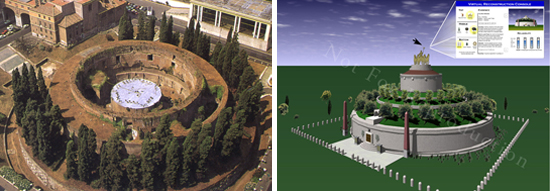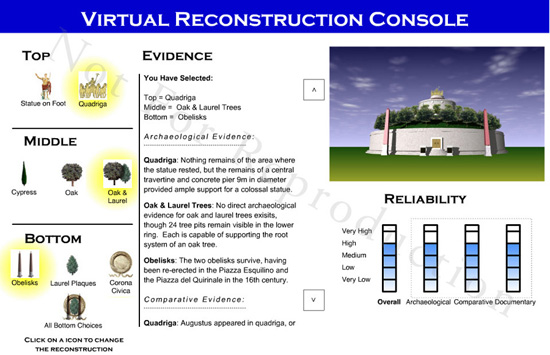|
3DVisA Resources 3DVisA Index of 3D Projects: Architectural and Urban Studies
Mausoleum of Augustus, Rome
The Mausoleum of Augustus is located on the ancient Campus Martius in the centre of Rome, on the east bank of the Tiber, a short stroll from the Piazza del Popolo.
It was constructed by Augustus as a dynastic burial place after his return from Egypt in 29 BC. The Mausoleum became dilapidated during the Middle Ages and was later misused
as a fortress, a limestone quarry, a garden and vineyard. In the 19th century it housed a concert hall. Restoration began after the hall closed in 1936, but all that remains
today from this magnificent monument is an empty shell. Another monument of the early Roman Empire, the nearby Altar of Augustan Peace, the Ara Pacis Augustae, consists
of original, elaborately sculpted fragments and modern plaster casts.

Fig. 1. The Mausoleum of Augustus in Rome and its digital reconstruction (in progress) © University of Southern California, Los Angeles. Reproduced with kind permission.
The Mausoleum of Augustus is a huge cylindrical structure, 88 m in diameter, with a series of concentric walls. Two granite obelisks in the Egyptian style, now in Piazza Quirinale
and Piazza del Esquilino respectively, flanked the entrance. Recent excavations have confirmed the original location of these obelisks, as well as the foundations for the two pillars
that bore the bronze tablets engraved with the Res Gestae of Augustus. It is believed that Augustus intended his mausoleum to outshine the famous tomb of king Mausolos at Halicarnassos,
yet to draw architectural inspiration from the tomb of Alexander the Great at Alexandria, which may have been a great circular tumulus. According to Strabo, the concentric walls of
the Mausoleum of Augustus were planted with evergreen trees, commonly - but possibly incorrectly - believed to be cypresses, which were planted on the tomb in 1938. The structure was
topped by a cylindrical core, which has not survived, and was crowned by a bronze statue of Augustus. Inside, a passage led to the funeral chamber with a tomb of the emperor; in
the surrounding area were located the marble urns containing the ashes of other members of the family, including Augustusís wife Livia, his sister Octavia, his nephew Marcellus,
and his son-in-law Agrippa.
Although much of the structure has survived and loose fragments have been excavated in modern times, the original design has been the subject of much speculation. There is also
much uncertainty about such elements of the structure as the form of the emperorís bronze statue: a full-length standing figure or a figure in a chariot are both assumptions.
The sculptural decoration of the entrance and the type of trees originally planted on the monument (oak, laurel, and cypress have been suggested) are also open to interpretation
despite considerable written evidence that includes Augustusís own record of his commissions, the Res Gestae, as well as his detailed instructions concerning his funeral.
Later sources, both written and iconographic, are also ambiguous. Among modern reconstructions are the 1938 one by Guglielmo Gatti and a more recent one by Henner von Hesberg of 1994.
They both differ in detail.
John Pollini, Professor of Classical Art and Archaeology at the University of Southern California, with the assistance of his graduate research assistant Nicholas Cipolla, created
a Virtual Reality computer model of the Mausoleum of Augustus as a tool for the study of this historic structure and for testing interpretations of it through visual means.
As part of the model Nicholas Cipolla created a console, which serves as an apparatus of scholarly tools. The console offers, among other tools, the option of looking at the
Mausoleum from different angles, including from ground level. Earlier reconstructions have not considered this viewing angle and have therefore proposed details that would have
appeared obscure to the spectator.

Fig. 2. Digital reconstruction (in progress) of the Mausoleum of Augustus in Rome. Digital tools for assessing the reliability of the computer model. © University of Southern California, Los Angeles. Reproduced with kind permission.
John Pollini and Nicholas Cipolla, with other researchers working on other Virtual Reality projects at the University of Southern California in Los Angeles, set out to ? in the words
of Pollini ? 'diminish the divide between the physical evidence and the virtual world', i.e. to explore visualisation techniques for making this ambiguity explicit in digital
reconstructions, so that when viewing 3D computer models of archaeological and architectural heritage, one is able to distinguish between the fragmentary physical evidence
and ancient literary and epigraphic sources on the one hand, and an interpretative reconstruction on the other. The Augustan Mausoleum project is governed by pedagogical concerns,
addressing the issue of ICT methods and visualisation tools suitable for data annotation and presentation. The console of the Mausoleum includes scrollable text commentaries
and the so-called 'reliability meter'. The 'meter' offers a graphic assessment of evidence and suggests a degree of likelihood of a particular suggested reconstruction.
Project dates: 2002-2008
Resource status: In progress.
Contributors: Research Collaborators, University of Southern California, Los Angeles: John Pollini, Professor of Classical Art and Archaeology, Department of Art
History; Lynn Swartz Dodd, Lecturer and Curator of the Taper Hall Archaeological Collection, School of Religion; Karen Kensek, Adjunct Associate Professor, School of Architecture
and Nicholas Cipolla, Research Assistant, USC and Getty Research Institute, CA, USA.
Sources and further details:
Pollini, J., Swartz Dodd, L., Kensek, K. and Cipolla, N., 'Problematics of Making Ambiguity Explicit in Virtual
Reconstructions: A Case Study of the Mausoleum of Augustus', Theory and Practice, Proceedings of the 21st Annual
Conference of CHArt: Computers and the History of Art, British Academy, London, November 2005.
J. Pollini, Dynastic Narratives in Augustan Art and Thought: The Rhetoric and Poetry of Visual Imagery (book in progress).
Record compiled by Anna Bentkowska-Kafel. Created: 11 September 2006. Last updated: 23 January 2007.
3DVisA gratefully acknowledges the help of Professor John Pollini with preparation of this record.
Back to the list of 3D projects
|
